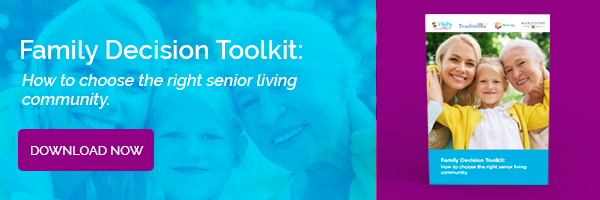It isn’t uncommon for a senior to want to age at home instead of moving to a senior community. For some it is due to sentimental reasons: they don’t want to give up the house they raised a family in and all the memories attached to it. For others it is due to financial concerns. They believe it is less expensive to age at home because their mortgage is paid off.
But aging at home isn’t always the best solution. In fact, senior living communities like Vitality help improve quality of life. From better nutrition to daily life enrichment activities, older adults who make the move to senior living have an opportunity to continue to learn and grow.
Learning how a senior living community is a smart financial decision and what types of funding are available might help you and your senior loved one plan for the future.
How to lay the foundation for such a future? Here are the key elements to consider as one explores financial opportunities in support of senior living options.
Amenities and Services Offered in Senior Living Communities
One thing to remember as you are deciding whether a senior should age at home or move to a senior community is just how many of their current expenses will be included in the basic monthly senior living fee.
A few examples of included expenses are:
- Housing — typically an apartment, villa or suite
- Delicious, well-balanced meals and snacks
- Transportation services
- Basic utilities
- Entertainment and outings
- Wellness programs
- Maintenance and repairs
- Housekeeping and laundry
- Emergency call system
- Security system
When you factor in the savings your older loved one will enjoy by not having to pay a variety of other expenses — such as property taxes or homeowner’s insurance — it’s easy to begin to see how senior living communities are more affordable than you think!
It also helps to make sure you are aware of the variety of programs that might help finance senior living.
Funding Options to Finance Senior Living
While the majority of expenses related to senior living are paid for using a family’s private resources, there are some programs that might be of help. From special assistance for veterans to bridge loans specifically for seniors, here’s a look at a few of the funding options your loved one may qualify for.
Short-term Bridge Loans
For most older adults, their greatest asset is their house. They usually need the proceeds from the sale of it to finance a move to senior living. But it often makes the transition a little less stressful if the senior can move before the house goes on the market.
This is where a bridge loan can be helpful.
These loans allow families to finance senior living expenses while they are preparing the house to be sold or are waiting for the most opportune time to sell investments.
While these loans can be arranged in a variety of ways, one popular option requires the senior to pay only the interest on the loan in the short-term. Once the asset has been liquidated the borrower pays back the loan in a lump sum.
Some financial institutions will split bridge loan payments among several family members. This allows adult children to help repay the bridge loan while waiting for the senior’s house to be sold.
Life Settlement Companies
Another option worth considering is to work with a reputable life settlement company if your loved one has a current life insurance policy.
By entering in to an agreement with a life settlement company, a senior can sell their life insurance policy to a third party. They will then receive a lump sum payment. While the reimbursement isn’t as much as the face value on their policy, it is usually significantly higher than the policy’s cash surrender value.
It is always best to talk with an experienced elder care attorney or estate planner before signing any life settlement contracts.
Veteran’s Aid & Attendance Benefit
Another potential source of funding for assisted living is the Veteran’s Aid & Attendance benefit. Many families of veterans aren’t even aware of it! If a veteran meets the qualifications, the awards can be significant.
In 2017, a veterans and their spouse might receive up to:
| Married Veteran: | $2,127 per month |
| Married Vet (spouse needs care): | $1408 per month |
| Single Veteran: | $1,794 per month |
| Surviving Spouse (no dependents): | $1,153 per month |
The U.S. Department of Veterans Affairs has more detailed information about the Aid & Attendance Benefit on their website.
Questions about Financing Senior Living?
This guide to long-term care financing will help you learn more about the various ways you can fund senior living.
If you have questions and would like to speak to someone in person, the experts at Vitality Senior Living will be happy to help. Contact us to schedule a time to talk at your convenience.




